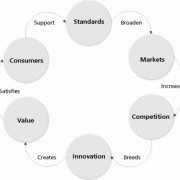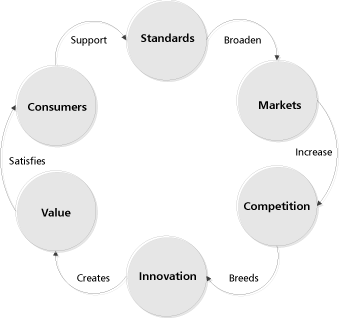
"Cloud computing represents a game-changing paradigm shift in the industry, with consumers (and the enterprises they serve) crying out for a broadened set of standards in areas where standards have never existed before."
-- Mitchell Ummel, Guest Editor
Opening Statement
The dialogue surrounding standards, standards-setting processes, and the overall benefit of standards is hardly a new one -- especially in the field of information technology. Few will argue with that claim -- ours is indeed an industry built on standards. In fact, we find the myriad foundational technologies upon which cloud computing services are typically built (including, but not limited to, TCP/IP, HTML, and XML) to be already decades mature in terms of standardization and industry adoption.
Why then the increasing interest in cloud computing standards in 2012? The answer is arguably quite simple: cloud computing represents a game-changing paradigm shift in the industry, with consumers (and the enterprises they serve) crying out for a broadened set of standards in areas where standards have never existed before.
Much is at stake as the cloud computing standards "battlefield" emerges.
BATTLEFIELD PLAYERS
Large, established vendors seek to carve out new (or protect existing) market share as they recast and rebrand their existing computing products and services to be marketecturally1 "cloud friendly." Small, new vendors seek to enter the marketplace, compete on a level playing field, and find opportunities to either innovate or position themselves as market followers -- promoting their wares as "cheaper, faster, better" (pick one or more) than the established competition's.
New markets develop with increasing velocity, as industries of "cloud brokers" or "cloud VARs" arise. We find thousands of startups are able to spin up tens of thousands of offerings on a daily basis with zero up-front investment ("Look, Ma, no VC required!") and ramp up capacity on demand if the offering is the one in 10,000 that goes viral -- for a day, a year, or (as the next Google or Facebook) for decades.
We, the consumers of cloud computing services, seek only the promise of value for our enterprise computing dollar, based upon a strong foundation of trust, assurance, and security. Figure 1 illustrates how consumer-driven standards may influence and broaden markets, increase competition and innovation, and lead to products and services with greater consumer value.

Figure 1 -- Standards value chain.
TALK ABOUT INTEROPERABILITY ...
The analogy between the evolution of the electric energy industry and cloud computing is oftentimes used, and for good reason. It's likely the most applicable predictor of where this industry is heading over the next 10-20 years.
Although slight regional variances exist, it's generally the case that I, as a consumer of electric power, can plug in my appliance anywhere in the world and expect it to work efficiently, safely, and reliably. Standards for voltage regulation, plug/outlet design, and circuit protection are mature and widely embraced, and the electric appliance industry can compete, and innovate, on a level playing field for the benefit of consumers worldwide. The clock radio in my office is one of thousands of such devices in the market today. It is a Japanese brand, with technologies patented in the US and subcomponents manufactured in South Korea. This amazing device, purchased for US $12, is incredibly reliable and runs on "pennies" of electrical power per week.
The emerging global cloud computing market space, built on a fabric of underlying standards promoting interoperability, security, assurance, and trust, also promises to amaze consumers in the coming decade. Current computing standards aside, the paradigm shift to the cloud compels us to address new areas of standardization where none have existed before. These include the following:
-
Industry-wide agreement and widespread adoption of standard terminology and measures for basic elemental units such as "compute instance," "compute-hour," "MB-month," and so on
-
Standard language and provisions guiding the overall structure and framework for a new generation of consumer-friendly cloud computing service-level agreements (SLAs)
-
Foundational standards for portability and interoperability of compute instances (virtual machines) across and among participating public cloud computing service providers, as well as private cloud architectures serving an enterprise
CLOUD COMPUTING 2020
One might imagine a not-too-distant future where consumers of standards-based cloud computing services are able to automatically and rapidly (i.e., in near real time) provision and re-provision their enterprise computing load across multiple competing providers based on a number of attributes, including instantaneous pricing, geographical region, temporal (time) shifting, service-level requirements, and so on. Standards will allow consumers to seamlessly move their computing load from their private cloud (enterprise data center) to public cloud providers and back again, as demand or failover requirements dictate.
In the future, we might even see a virtual "stock market" develop for brokers or aggregators of cloud computing services -- where compute instances, capacity, and options are traded, in real time, much like stocks are traded on a stock exchange. Enterprises that continue to invest in "bare metal" data center capacity and subscribe to industry cloud computing standards for interoperability may even have the opportunity to sell excess capacity back to the "grid," in much the same way that a homeowner with a residential wind power generator can sell back excess power to the grid in utility markets that provide "net metering" capabilities.
TRUTH IN CLOUD COMPUTING
Akin to truth in lending requirements for financial institutions offering mortgages, or truth in labeling requirements for the food and drug industry, consumers of cloud computing services may soon demand a truth in computing "label" on services they consume. Such a label would allow for easy comparison of pricing among competing providers, and assurance of elemental service-level capability and interoperability, as a means to promote and enforce a basic level of transparency and accountability among vendors in the marketplace.
IN THIS ISSUE
How does this all play out? Our contributing authors tackle this topic head on in this month's issue of Cutter IT Journal. Now let me introduce these authors, each of whom contributes to our understanding of this broad subject area through their insights and unique domain knowledge.
Carlos Viniegra's thoughtful article sets the stage with a foundational discussion of standards setting in general. He writes that "economic history shows us that consumers will take advantage of savings and drive markets toward their optimal economies of scale." Viniegra further explores the motivation for stakeholders involved in standardization and the behavior types that typically exist in the context of "agency theory." He then presents three "information asymmetry" problems that, according to him, will increase the pressure for government regulation in this market.
Next, coauthors Duff Bailey and Jeffrey Wu promote the expansion of beneficial standards in the cloud computing space. While they recognize that government regulation and certification will continue to play a role, they also argue that it will be primarily market forces that drive even the largest of cloud vendors to standardization.
In our third article, David Bernstein presents a core theme that a standard is not a document but a process. Within his article, he reflects upon past standards-setting-as-a-process experiences from the early days of Ethernet leading up to and including WLAN and related wireless security protocols. He further concludes that we are stuck in a cloud computing "early adopter" stage with consumer confidence, in the absence of practical standards, sorely lacking.
Next, Cutter Senior Consultant and cloud computing expert Claude Baudoin promotes a consumer/customer-driven (vs. industry-driven) standards-setting focus. He also provides a rundown of the numerous complementary, and sometimes competing, standards-setting initiatives already underway. Baudoin argues that, due to the rapidly moving cloud adoption cycle, we the users must become active, making our voices heard through initiatives such as the OMG-affiliated Cloud Standards Customer Council (CSCC), an organization that is attempting to prioritize and harmonize cloud standards-setting activities among all standards bodies that are active today.
Our fifth author, Beth Cohen, explores the interrelation between cloud computing standards efforts and the open source movement. Her deep dive into the frameworks and technologies that make up "de facto" cloud standards suggests that the open source community is best positioned to address the standards "gap" that currently exists in cloud computing. Her bold article, entitled "An Open Source Approach to IaaS Cloud Standards," is a technical delight.
And last but not least, Aditya Watal leads us through the cloud computing "stack" from SaaS, through PaaS, to IaaS, and in the process presents a unique vantage point on the viability of standards at each layer. Suggesting that the greatest opportunities for standardization exist at the PaaS layer, Watal profiles the top six PaaS offerings on the market today, assessing them against his proposed Cloud Architecture Reference Model for Applications (CARMA). He then goes on to describe "what an ideal application sitting on such a standards-compliant platform would look like."
CALL FOR ACTION
We at Cutter Consortium are seeing an increasing interest by our readers in learning more about cloud computing standards setting, how to become involved in those efforts, and how best to practically embrace cloud computing within their organizations as part of an enterprise cloud computing strategic roadmap. We are interested in your feedback and success stories in this area and would seek to include your experiences in future research published by Cutter.
ENDNOTE
1 According to Wikipedia, "Marchitecture (or Marketecture) is a portmanteau of the words 'marketing' and 'architecture.' The term is applied to any form of electronic architecture perceived to have been produced purely for marketing reasons. It may be used by a vendor to place itself in such a way as to promote all [its] strongest abilities whilst simultaneously masking [its] weaknesses."
ABOUT THE AUTHOR
Why then the increasing interest in cloud computing standards in 2012? The answer is arguably quite simple: cloud computing represents a game-changing paradigm shift in the industry, with consumers (and the enterprises they serve) crying out for a broadened set of standards in areas where standards have never existed before. How does this all play out? Our contributing authors tackle this topic head on in this month's issue of Cutter IT Journal.








